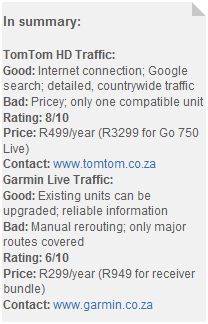
There are many different providers of GPS services – and it is often difficult for consumers to compare these products. Not all sales people have the knowledge to compare products with one another – and it is difficult to find an independent view from a knowledgeable person without a vested interest in any of these products.
I have come across a great summary by Christo van Gemert, an ITWeb journalist. His story on ITWeb is titled Satnav put to traffic test.
We would like to quote from his analysis:
“Readers in the Gauteng region will be familiar with this: you’re listening to your favourite CD or radio station. Suddenly, the beats are interrupted by a now-familiar jingle, and an announcer starts reading the traffic. The station offering these traffic announcements is Classic FM and the automated system is realised through RDS, or Radio Data System. It’s a protocol that embeds bits of digital information in the radio broadcast – in this case, Classic FM sends out a ‘switch’ that tells your car radio to tune into the traffic report (assuming the TA option is enabled).
This is a basic system, of course. Getting traffic through radio stations has become a habit but, with half-hourly updates, often including outdated information, it’s not exactly reliable. Plus, it’s usually only available in peak hours.
Real-time traffic data has only been available for quite some time in those countries with more advanced infrastructure. Getting those systems up and running is a bit more complicated than a radio station getting traffic updates from listeners or a helicopter, then broadcasting it.
A lot of data needs to be gathered and sorted. That data has to come from somewhere, and that is where the new services from TomTom and Garmin differ.

Does it work?
First up, Garmin Live Traffic. A partnership with local tracking company, Altech NetStar, gives Garmin’s service a source for real-time information. Customers can opt in to share their location data with Altech Netstar, and this data is then collated. If 50 cars are stuck in a jam it shows up as 50 valid data sources, and the system recognises the snarl-up. Data is disseminated through RDS, the same system your car radio uses, and picked up by a Garmin Traffic Receiver. This is a little doodad that sits in the charging cable for your Garmin GPS – and yes, if you have a 1000-series Garmin nüvi you can buy this receiver separately and ‘upgrade’ your existing navigation unit with traffic capabilities. Garmin will also be releasing the 1300T, with an integrated traffic receiver.
The Garmin system isn’t perfect, though. There are a limited number of cars providing satellite coordinates, which makes it harder to reach saturation point for certain roads. Indeed, only main roads are usually on the map, making congested suburban routes a hit-or-miss commuting gamble. Additionally, users need to intervene manually to avoid traffic. When a route is plotted and traffic is detected, a second screen needs to be selected to bypass any jams.
Traffic information for Garmin Live Traffic is currently only available in Gauteng – though other metropolitan areas will get full coverage, soon, Garmin says.
Things are done differently with the TomTom. The HD Traffic service uses more granular information. According to TomTom, positioning data comes from official services (such as municipal traffic reports), existing GPS probes and GSM data – basically, information from cellphone towers. As a result, there are more data points for detecting any tie-ups, and this can even cover suburban roads. Routing around traffic is also automated, with no user input required.
HD Traffic doesn’t use RDS, though. Instead, it is fitted with a GSM module and has an actual Internet connection for receiving traffic updates from the Internet. This also endows it with a very powerful Google search function – now you can find all the restaurants in your vicinity, along with review ratings and contact details. This two-way link also lets users pinpoint traffic cameras and share the information with the TomTom map servers.
Should I buy it?
TomTom’s service is far more modern, but that comes at a higher price. Only one of its portable navigation units supports the service, the Go 750 Live, and that retails for R3 299 (with a one-year subscription). Annual subscription to HD Traffic is R499.
Shop around and you can have Garmin’s cheapest nüvi, the 1200, for about R1 700. Add R949 for the traffic bundle (receiver plus one-year subscription), and the total retail difference is just R650. Add another R299 a year for the Live Traffic subscription. If you already have a compatible Garmin unit, it’s only R950 you need to spend – existing TomTom users have no upgrade options.
Garmin offers an appealing package for those who travel on main routes and already own a unit, but for first-time buyers the TomTom Go 750 Live, as the only traffic unit from that company, is the one to get.
[Information with credit to Christo van Gemert, ITWeb]


